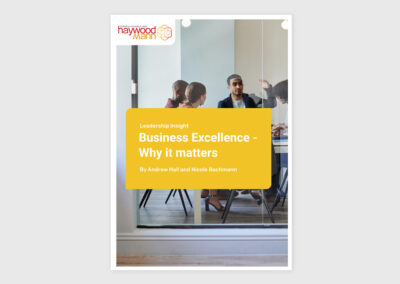Co-author: Andrew Hall
What is Organisational Health?
Organisational Health is a measure of the ability of an organisation/business to be highly adaptable to changes in its environment and thereby develop and sustain its competitive advantage over the long term.
A healthy organisation maintains strength in three critical traits, which we characterise as the internal alignment of all business activities, the quality of execution throughout the organisation and an external focus that utilises what is happening in the broader business environment to its advantage.
Internal Alignment within a business produces:
• Shared objectives, supported by the culture and climate of the organization and meaningful to each employee
• Energy and efforts of all staff focused on achievement of business goals
• Increased contribution of all staff to productivity and delivery of results
• Improved bottom line
Quality of execution results in:
• Right first time – minimal levels of rework
• Consistently high quality of delivery (in all aspects of the business – internal & external)
• High client satisfaction
• Great reputation
• Winning/retaining clients easily
• Recruiting/retaining the right talent
External focus delivers:
• High quality engagement with customers, suppliers, partners, etc
• Continual drive for value
• Ability to tailor current and future offerings to the market
• Continued competitive growth
These three traits are established and sustained by a blend of eight organisational attributes – Leadership, Followership, Empathy, Competence, Rigour, Confidence, Capability and Innovation. The strength of these attributes determines the health of an organisation and, consequently, the extent to which it can adapt to changing circumstances better than its competition.
Organisational Health Explained
In the following section we provide an explanation of the attributes of Internal Alignment, Quality of Execution and External Focus shownin this diagram >.
INTERNAL ALIGNMENT:
Internal Alignment delivers shared objectives that are meaningful to all your people. Everyone’s energy and efforts are focused on the achievement of business goals. Consequently productivity, results and the bottom line increase.
The following attributes are critical to achieving true alignment:
Leadership
Leadership in respect of Internal Alignment is about the quality of the climate set by the leaders of the business and the extent to which they provide a clear sense of direction and promote shared objectives.
In the healthiest organisations this is evidenced by:
- All managers taking a coaching approach to leading their people
- Everyone being encouraged to be proactive and entrepreneurial in their daily activities
- Managers across the organisation recognising the achievements of their teams
- Everyone in the business being clear about the strategy and direction
- Resources being allocated to matters appropriate to the balance between client profitability and delivering client value
Followership
Followership in respect of Internal Alignment is about a culture of enthusiasm that inspires employees to put in extraordinary efforts to deliver results for the business and its clients.
In the healthiest organisations this is evidenced by:
- All people taking responsibility for their actions
- Everyone eagerly supporting change
- People being highly motivated
- Levels of staff loyalty being very high throughout the organisation
- People being eager to own projects and take them forward because they clearly understand their role in delivering the strategy
- Everyone in the business being aligned to deliver the strategy effectively
- Performance measures being highly effective and delivering high levels of commitment from everyone
- Business leaders across all functions accepting ownership of the financial results of the whole business
- Everyone appreciating what an acceptable level of client profitability is
Empathy
In this context, empathy means the extent to which there is a culture of transparency and openness, with people consistently giving each other both affirmative and corrective feedback.
In the healthiest organisations this is evidenced by:
- Internal communication being open and effective throughout the company
- All people collaborating effectively with internal and external stakeholders
- Everyone in the organisation focusing on continuous improvement across the organisation by challenging existing procedures and processes
- All business leaders having confidence in the ability of the business to fund the growth strategy
- People having clarity and confidence about the financial planning processes
Competence
In this context, competence means the ability of all individuals to perform their role in a self-directed manner, achieving high levels of productivity and the desired results for clients and the business.
In the healthiest organisations this is evidenced by:
- Everyone adopting a proactive approach to collaboration throughout the business
- Everyone focusing on innovation in their sphere of influence for the benefit of the whole organisation
- All people being focused on delivering a continually fantastic experience for all clients
- All teams delivering outstanding performance, because the people understand how to work effectively in teams
- Thoroughly understanding the markets they operate in and aligning their offering accordingly
- Delivering outstanding service on time and to budget
Rigour
In this context rigour means the discipline to evaluate performance, behaviour and risk against agreed standards across the organisation, with a focus on accountability.
In the healthiest organisations this is evidenced by:
- The focus of all activities in the business on learning from failures and successes
- Everyone understanding how the organisation works
- All investment decisions being aligned with the strategic growth plan and adjusted according to changes in the external environment
- All investment decisions being made against a robust business case to ensure alignment with profitability growth targets
QUALITY OF EXECUTION:
High quality of execution results in a consistently high standard of delivery in all aspects of business activity – both internally and externally. You get things right first time. Your clients are satisfied with all you do and therefore stay with you. It becomes easier to attract new good clients – and the same goes for recruiting and retaining the right talent.
The following attributes are critical to achieving high quality of execution:
Leadership
Leadership in the context of Quality of Execution is about the quality of management being very high and setting a tone/culture that focuses on delivery standards, which motivates everyone in the company to be mindful about what the organisation wants to achieve.
In the healthiest organisations this is evidenced by:
- The organisation getting the best performance out of all its people
- Maintaining collective focus on delivering client value as a business
- The company having the capacity to self-fund its growth aspirations
- Having the ability to deliver regular step changes in performance due to continual critical review of the operations
- The financial management systems making up-to-the-minute reports available to all business leaders, including on economic trends and financial drivers
Followership
Followership in respect of Quality of Execution means everyone in the organisation putting in extraordinary effort continuously and taking responsibility for their own performance and contribution to the overall result.
In the healthiest organisations this is evidenced by:
- Everyone focusing on innovating in their sphere of influence for the benefit of the whole organisation
- Teams delivering outstanding performance because the people understand how to work effectively in teams
- The business having fully functional processes in place that are applied effectively
- The company achieving an excellent return on their sales and marketing investment
- The organisation having good liquidity, strong cash flow and adequate capital
- All business leaders assuring credit control is effective and making informed decisions on expenditure and investment
- The business delivering good profits performance against its forecasts
Confidence
Confidence in the context of Quality of Execution is reflected in certainty and conviction arising from clarity about purpose and direction. Consequently, everyone in the business wants to excel and engages constructively with internal and external stakeholders.
In the healthiest organisations this is evidenced by:
- Everyone adopting a proactive approach to collaboration throughout the business
- All people collaborating effectively with internal and external stakeholders
- The whole business being focused on delivering a continually fantastic experience for all clients
- Everyone being willing to go the extra mile to deliver benefit to their colleagues, the company and its clients
- Sales activities creating consistent growth of new and incremental business
- The quality and consistency of the organisation’s financial performance making credit easily available to the business
Capability
In the context of Quality of Execution, Capability relates to effective systems and processes in combination with collective skills and talents ensuring the business gets it right first time, with the necessary co-ordination and control.
In the healthiest organisations this is evidenced by:
- The organisation having a communication structure that ensures everyone has the information they need to perform at their best
- Everyone being open to sharing issues and to implementing solutions regardless of their source
- All people operating on a high level of effectiveness and efficiency across the organisation
- Resources being used optimally throughout the business, with wastage kept to a minimum
- The business delivering its expected profit margins
- Operating a rigorous, structured approach to lead generation and conversion of sales
- The business managing its costs effectively and delivering profitable revenue
- A continuing adequate capitalisation of the business, due to effective management of working capital
- Effective budgeting and forecasting being undertaken across all departments
Competence
Competence in the context of Quality of Execution means everyone understands their role and objectives because the right people are put in the right roles,. This allows them to perform in a self-motivated and directed way.
In the healthiest organisations this is evidenced by:
- Everyone being willing to step forward and take ownership to achieve the agreed outcomes
- Everyone throughout the business achieving optimal operational results
- The structures and processes of the business underpinning a highly collaborative attitude between all functions/departments
- The business achieving optimal productivity through using its resources effectively
- The effective use of capital underpinning a consistently positive cash flow
- All business leaders being confident and effective in their expenditure decisions
Rigour
In respect of Quality of Execution, Rigour is about the systems and operational discipline ensuring clear lines of accountability and the required attention to detail to contribute to getting things right first time.
In the healthiest organisations this is evidenced by:
- All departments achieving significant effectiveness gains across the business by utilising synergies with all its stakeholders
- The resource deployment focusing on fitness for purpose, with costs and rewards carefully balanced
- The business delivering successful outcomes on time and to budget
- The organisation getting things right first time and therefore there is rarely need for re-work
- The procurement management being highly effective, which is reflected in the cost-competitiveness of the services and resources it acquires
- All business units delivering financial performance in line with plan
- Client lists being rigorously reviewed and appropriate actions taken to retain only those that are able to deliver acceptable profitability
EXTERNAL FOCUS:
External focus is an essential element of continued competitive growth. It fosters the ability to tailor current and future offerings to the market, which is a constant driver for client value. High quality of engagement with external stakeholders produces the ability to utilise what is happening in the broader business environment to your advantage. In today’s market this is even more critical as technology creates new business opportunities and competition daily.
The following attributes are critical to keeping your business externally focused:
Leadership
In respect of External Focus, Leadership is about your entire leadership being externally oriented and promoting a culture of constant learning from success as well as failure. This inspires action throughout the business to continually improve.
In the healthiest organisations this is evidenced by:
- Everyone being encouraged to be proactive and entrepreneurial in their daily activities
- Everyone contributing proactively to the initiation and maintenance of external relationships
- Maintaining a collective focus on delivering client value
- All key people being measured on the effectiveness of their external engagement to promote best practice
- The business thoroughly understanding the markets it operates in and aligning its offerings accordingly
- Investment decisions being aligned with the organisation’s strategic growth plan and adjusted according to changes in the external environment
- Resources being allocated to matters appropriate to the balance between client profitability and delivering client value.
Empathy
Empathy in the context of External Focus denotes a culture of continuous learning where everyone seeks to understand each other, the business and the market by listening on a focused level. This naturally leads to sharing of knowledge, which promotes innovation.
In the healthiest organisations this is evidenced by:
- Everyone collaborating effectively with internal and external stakeholders
- The business listening carefully to the needs of its clients and reflecting these in its approach to delivering its services
- Tailoring the company’s products/services to the expressed needs and wants of its customers
- Achieving high levels of client satisfaction
- Achieving high levels of repeat business and numerous good referrals
Confidence
In respect of External Focus, Confidence is about being fired by trust in the quality of the business, which results in keeping all communication as transparent as possible, driving and promoting best practice internally and within the industry/sector.
In the healthiest organisations this is evidenced by:
- Achieving significant effectiveness gains across the business by utilising synergies with the business’ stakeholders
- Proactively seeking opportunities to collaborate with the organisation’s customers in order to foster innovative solutions for their benefit
- The company’s marketing being highly targeted and very effective in generating prospects
- The organisation’s strong financial position and fair treatment of suppliers enabling it to secure productive long term relationships with them
- The business achieving favourable terms and prices in its supplier contracts
Innovation
Innovation in the context of External Focus signifies constructive disruption is the way of operating, which guarantees the quality and flow of new ideas, as well as the ability to continuously adapt to new circumstances.
In the healthiest organisations this is evidenced by:
- The focus of all activities on learning from failures and successes
- Everyone focusing on innovating in their sphere of influence for the benefit of the whole organisation
- Proactively seeking valuable connections for the company’s customers to foster referrals and business opportunities for them
- Achieving an excellent return on the business’ sales and marketing investment
- The organisation’s financial management system making up-to-the-minute reports available to all business leaders, including on economic trends and financial drivers
If you want to explore this further and assess the health of your own organisation, please get in touch with us.


